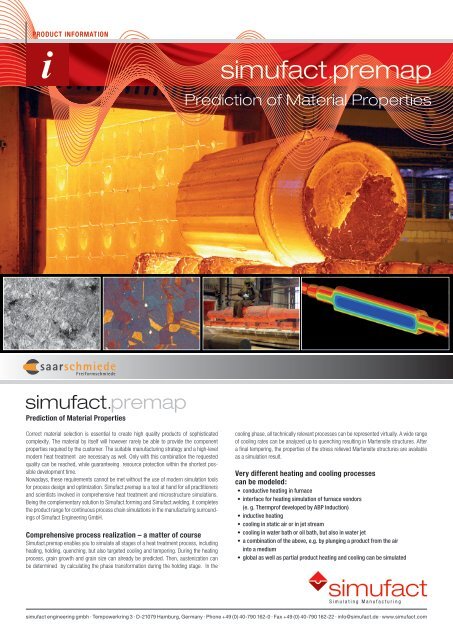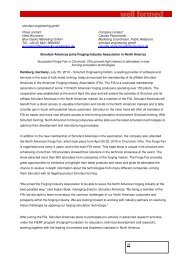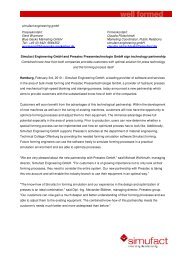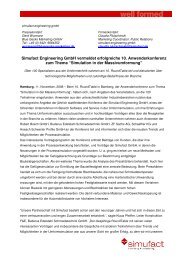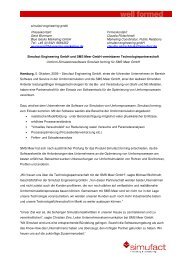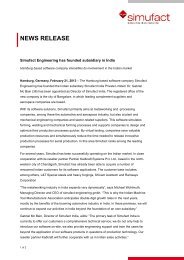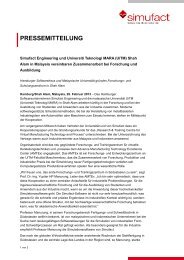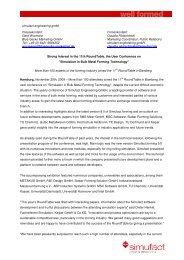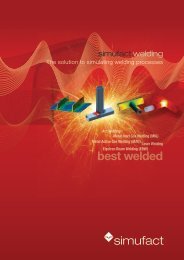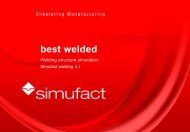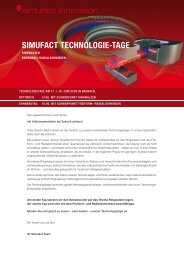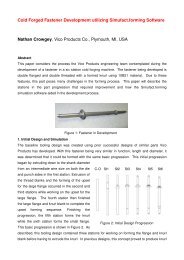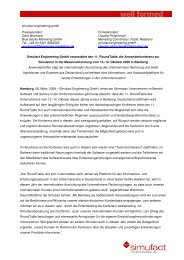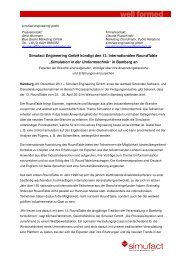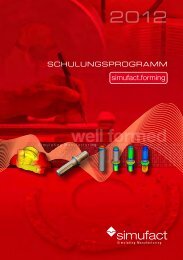Simufact.premap ? Prediction of Material Properties (PDF, 2 MB)
Simufact.premap ? Prediction of Material Properties (PDF, 2 MB)
Simufact.premap ? Prediction of Material Properties (PDF, 2 MB)
Create successful ePaper yourself
Turn your PDF publications into a flip-book with our unique Google optimized e-Paper software.
ProduCt information<br />
i simufact <strong>premap</strong><br />
simufact <strong>premap</strong><br />
<strong>Prediction</strong> <strong>of</strong> <strong>Material</strong> <strong>Properties</strong><br />
Correct material selection is essential to create high quality products <strong>of</strong> sophisticated<br />
complexity. The material by itself will however rarely be able to provide the component<br />
properties required by the customer. The suitable manufacturing strategy and a high-level<br />
modern heat treatment are necessary as well. Only with this combination the requested<br />
quality can be reached, while guaranteeing resource protection within the shortest possible<br />
development time.<br />
Nowadays, these requirements cannot be met without the use <strong>of</strong> modern simulation tools<br />
for process design and optimization. <strong>Simufact</strong>.<strong>premap</strong> is a tool at hand for all practitioners<br />
and scientists involved in comprehensive heat treatment and microstructure simulations.<br />
Being the complementary solution to <strong>Simufact</strong>.forming and <strong>Simufact</strong>.welding, it completes<br />
the product range for continuous process chain simulations in the manufacturing surroundings<br />
<strong>of</strong> <strong>Simufact</strong> Engineering GmbH.<br />
Comprehensive process realization – a matter <strong>of</strong> course<br />
<strong>Simufact</strong>.<strong>premap</strong> enables you to simulate all stages <strong>of</strong> a heat treatment process, including<br />
heating, holding, quenching, but also targeted cooling and tempering. During the heating<br />
process, grain growth and grain size can already be predicted. Then, austenization can<br />
be determined by calculating the phase transformation during the holding stage. In the<br />
<strong>Prediction</strong> <strong>of</strong> <strong>Material</strong> <strong>Properties</strong><br />
cooling phase, all technically relevant processes can be represented virtually. A wide range<br />
<strong>of</strong> cooling rates can be analyzed up to quenching resulting in Martensite structures. After<br />
a final tempering, the properties <strong>of</strong> the stress relieved Martensite structures are available<br />
as a simulation result.<br />
Very different heating and cooling processes<br />
can be modeled:<br />
• conductive heating in furnace<br />
• interface for heating simulation <strong>of</strong> furnace vendors<br />
(e. g. Thermpr<strong>of</strong> developed by ABP Induction)<br />
• inductive heating<br />
• cooling in static air or in jet stream<br />
• cooling in water bath or oil bath, but also in water jet<br />
• a combination <strong>of</strong> the above, e.g. by plunging a product from the air<br />
into a medium<br />
• global as well as partial product heating and cooling can be simulated<br />
simufact engineering gmbh · Tempowerkring 3 · D-21079 Hamburg, Germany · Phone +49 (0) 40-790 162-0 · Fax +49 (0) 40-790 162-22 · info@simufact.de · www.simufact.com
ProduCt information<br />
simufact <strong>premap</strong><br />
<strong>Prediction</strong> <strong>of</strong> <strong>Material</strong> <strong>Properties</strong><br />
All currently well-established hardening mechanisms are supported: Martensitic hardening<br />
<strong>of</strong> steel, but also precipitation hardening for Aluminium or AFP-steels. Case hardening<br />
based on diffusion, such as carbonizing, nitrating and carbo-nitrating, is also supported.<br />
<strong>Simufact</strong>.<strong>premap</strong>`s scope <strong>of</strong> work is rounded <strong>of</strong>f by representing normalization and homogenization<br />
as well as by simulating the Jominy Test.<br />
<strong>Material</strong> parameters – the key to a realistic heat treatment<br />
simulation<br />
<strong>Material</strong> data depend on many parameters. In <strong>Simufact</strong>.<strong>premap</strong>, material data are used<br />
depending on many physical state variables. For example, the material characteristics<br />
are dependent on chemical composition, phase composition, grain size and temperature.<br />
Moreover, the yield stress depends on the true strain and the strain rate.<br />
Available material data in <strong>Simufact</strong>.<strong>premap</strong>:<br />
• young´s modulus<br />
• thermal expansion (coefficient)<br />
• thermal conductivity<br />
• posson´s ratio<br />
• density<br />
• yield stress<br />
© simufact engineering gmbh 2011<br />
ASTM<br />
In case <strong>of</strong> multiple phase structures the material parameters are calculated using the fractions<br />
<strong>of</strong> the individual phases. The calculation is based on isothermal transformation diagrams<br />
(TTT-diagrams) and continuous cooling diagrams (CCT). The detected phases are<br />
Austenite, Martensite, Bainite, Pearlite and Ferrite.<br />
The correct determination <strong>of</strong> a parameter requires a precise, process-dependent temperature<br />
representation. In this sense, the external heat transfer to the environment or to the<br />
tools is calculated as well as the internal temperature evolution which results from conductivity,<br />
plastic deformation, specific heat capacity and the latent heat.<br />
A realistic mechanical material characterization is ensured by considering the changes in<br />
volume. This may result from thermal expansion (whereby <strong>Simufact</strong>.<strong>premap</strong> also considers<br />
latent heat) but also from grid conversion <strong>of</strong> e.g. a face-centered cubic grid into a bodycentered<br />
cubic grid.<br />
In the context <strong>of</strong> simulating a process chain, the material parameters are continuously<br />
adjusting to the evolving material properties. To undertake a sensitivity analysis <strong>of</strong> the<br />
parameters it is possible to create data sets using the upper and lower bound <strong>of</strong> the chemical<br />
composition.<br />
Simulation results can evaluate the quality <strong>of</strong> a process<br />
To review a product and the corresponding manufacturing processes, the developer can<br />
use a variety <strong>of</strong> results.<br />
In order to describe the microstructure, phases and phase composition <strong>of</strong> Martensite,<br />
Bainite, Pearlite, Ferrite and residual Austenite are displayed. Grain size can be displayed<br />
as a result <strong>of</strong> grain growth in micrometers or ASTM, with or without dynamic and static recrystallization.<br />
In case hardening, penetration depth <strong>of</strong> carbon and nitrite can be analyzed.<br />
After a simulation, many relevant mechanical process parameters are available: hardness,<br />
yield strength, tensile stress, pro<strong>of</strong> stress. Further physical quantities important to evaluate<br />
the performance characteristics <strong>of</strong> a structure will gradually be integrated into <strong>Simufact</strong>.<br />
<strong>premap</strong>.<br />
Of course, all results can be displayed and evaluated at any time <strong>of</strong> the process and in any<br />
location <strong>of</strong> the component.<br />
A very important result <strong>of</strong> simulating material behavior is the geometrical distortion and<br />
thus the possible representation <strong>of</strong> the real geometry <strong>of</strong> a component undergoing processrelated<br />
residual stress.<br />
simufact engineering gmbh · Tempowerkring 3 · D-21079 Hamburg, Germany · Phone +49 (0) 40-790 162-0 · Fax +49 (0) 40-790 162-22 · info@simufact.de · www.simufact.com<br />
10<br />
8<br />
6<br />
4<br />
Powerful simulation approaches for correct material analysis<br />
Guarantor for a first-class, precise process simulation – also in case <strong>of</strong> heat treatment – is<br />
the use <strong>of</strong> powerful non-linear solvers. <strong>Simufact</strong>.<strong>premap</strong> is based on the approved technology<br />
<strong>of</strong> MSC.Marc <strong>of</strong> the global market leader MSC.S<strong>of</strong>tware, which has been established<br />
for decades.<br />
A fully thermal-mechanical, elastic-plastic coupled analysis which also supports the socalled<br />
multi-physics approach <strong>of</strong> complex material kinetics is facilitated.<br />
The Finite-Element Solver by MSC.S<strong>of</strong>tware are fast and well-engineered and allow <strong>of</strong><br />
course a parallel computing on modern high performance work stations and clusters using<br />
Windows and Linux operating systems.<br />
For modeling structures and components, all relevant 2D and 3D meshing technologies<br />
are available. Apart from the wide-spread tetrahedral meshing, innovative quad- and hexelement<br />
meshing technology is implemented within <strong>Simufact</strong>.<strong>premap</strong> and guarantees the<br />
highest possible result quality.<br />
Inverse calculation <strong>of</strong> heat transfer coefficient based on automated optimization leads to<br />
maximum precision in material simulation.<br />
<strong>Simufact</strong>.<strong>premap</strong> is a s<strong>of</strong>tware solution which can be used as a stand-alone system for the<br />
simulation <strong>of</strong> heat treatment processes and the calculation <strong>of</strong> material properties. Moreover,<br />
the process designer also owns a powerful tool for analysis <strong>of</strong> microstructure evolution<br />
and for calculation <strong>of</strong> material properties within the s<strong>of</strong>tware environment <strong>of</strong> <strong>Simufact</strong>.<br />
forming and <strong>Simufact</strong>.welding.<br />
Thus <strong>Simufact</strong>.<strong>premap</strong> becomes an essential part <strong>of</strong> an innovative process chain simulation.<br />
Scenarios as e.g. a forming simulation which incorporates results from a previous casting<br />
simulation <strong>of</strong> the semi-finished product, then followed by a joining simulation and finally a<br />
virtual heat treatment analysis will soon become the state <strong>of</strong> the art <strong>of</strong> innovative engineering<br />
and will be providing the starting point for the final component structural FEA.


